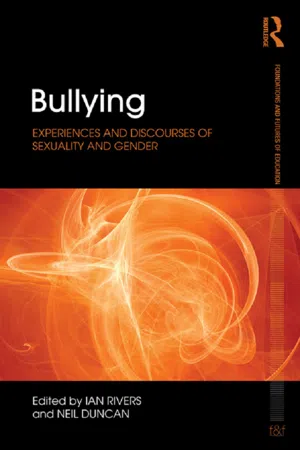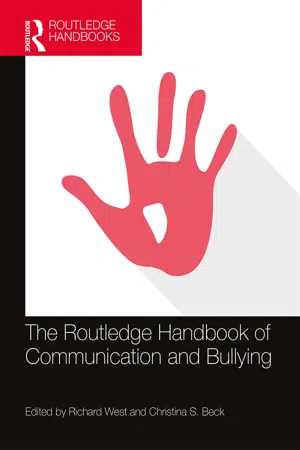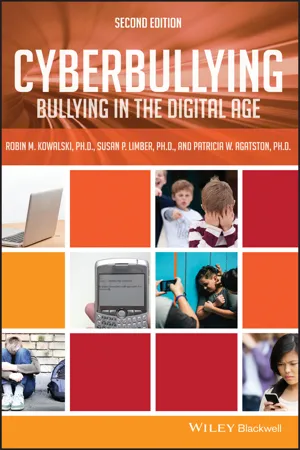Computer Science
Cyberbullying
Cyberbullying refers to the use of electronic communication to intimidate, harass, or harm others. This can occur through various digital platforms such as social media, messaging apps, or online forums. Cyberbullying can have serious psychological and emotional effects on the victims and is a growing concern in the digital age.
Written by Perlego with AI-assistance
Related key terms
5 Key excerpts on "Cyberbullying"
- eBook - ePub
Cyberbullying
Approaches, Consequences and Interventions
- Lucy R. Betts(Author)
- 2016(Publication Date)
- Palgrave Pivot(Publisher)
29). Cyberbullying involves ‘repeated use of technology to harass, humiliate, or threaten’ (Holladay, 2011, p. 4). ‘Cyberbullying is defined as the intentional act of online/digital intimidation, embarrassment, or harassment’ (Mark & Ratliffe, 2011, p. 92). Cyberbullying is ‘any peer-targeted aggressive behaviour via electronic communication technologies’ (Mehari et al., 2014, p. 400). Cyberbullying as ‘willful and repeated harm inflicted through the medium of electronic text’ (Patchin & Hinduja, 2006, p. 152). Cyberbullying is ‘repeated unwanted, hurtful, harassing, and/or threatening interaction through electronic communication media’ (Rafferty & Vander Ven, 2014, p. 364). Electronic bullying is ‘a means of bullying in which peers use electronics to taunt, insult, threaten, harass, and/or intimidate a peer’ (Raskauskas & Stoltz, 2007, p. 565). ‘Cyberbullying is a systematic abuse of power which occurs through the use of information and communication technologies (ICTs)’ (Slonje et al., 2013, p. 26). ‘Cyberbullying is any behavior performed through electronic or digital media by individuals or groups that repeatedly communicates hostile or aggressive messages intended to inflict harm or discomfort on others’ (Tokunaga, 2010, p. 278). ‘Cyberbullying occurs when Internet-based applications are used to systematically intimidate or insult a person so as to humiliate, embarrass, or hurt that person. Similar to offline bullying, Cyberbullying involves intentional repetitive actions and psychological violence’ (Valkenburg & Peter, 2011, pp. 124–125). Cyberbullying is ‘a form of aggression that occurs through personal computers (e.g., e-mail and instant messaging) or cell phones (e.g., text messaging)’ (Wang, Iannotti, & Nansel, 2009, p. 369). “When we say cyberbullied, we mean bullied through email, instant messaging, social media, in a chat room, on a website, in an online game, or through a text message sent to a cell phone - eBook - ePub
Bullying
Experiences and discourses of sexuality and gender
- Ian Rivers, Neil Duncan(Authors)
- 2013(Publication Date)
- Routledge(Publisher)
Today children and young people have the potential to interact with others in ways that only a decade ago we could not envisage. The evolution of internetready mobile/cell phones, greater access to the internet through games consoles and our increasing reliance upon electronic forms of communication mean that electronic information about individuals is globally accessible and therefore also readily available to those who seek to discriminate, intimidate or exploit vulnerable others. In this chapter, the focus turns to the sexualised and gendered nature of hostile electronic and online interactions between young people (principally adolescents) and other ‘users’, both peers and adults. While there is ever-increasing evidence that young people represent a particularly vulnerable group of users of technology, they are, more than any other generation, also experts or ‘digital natives’ in the manipulation of this technology for their own ends. From a relatively early age they have learnt, more so than many adults, how to navigate around net-nannies, hide illicit conversations, delete tracking histories and explore worlds once considered ‘adult’, without a parent or guardian ever knowing. Yet, for all this expertise, rarely do the skills they show online incorporate an understanding of risk avoidance or risk management (Byron, 2008), and perhaps more pertinently research has shown that these digital ‘natives’not only fail to maintain control of their online identities but their investment in online relationships is such that they fail to see the threats associated with increased disclosure of personal information. Ultimately, online disclosure can result in offline vulnerability to many different forms of exploitation.Definitions of Cyberbullying and CyberaggressionCyberbullying is a form of aggressive behaviour that occurs through electronic devices such as mobile/cell phones (calls and SMS/text messages), e-mail and the internet (blogs, chatrooms, newsgroups, social networks and web-pages). Like other forms of bullying, Cyberbullying is usually defined in terms of intentional and repeated interactions on the part of the perpetrator who is perceived to be more powerful than the victim: the perpetrator’s ability to act anonymously is indicative of a form of power he or she holds over the victim (Wolak et al., 2007). The perpetrator then seeks to harm, exploit or denigrate the status of that individual.By way of contrast, cyberaggression can be defined as any form of communication mediated through an electronic device where the purpose is to harm or otherwise exploit an individual physically, sexually and/or emotionally (Grigg, 2010). Cyberaggression can include single incidents as well as those that are repeated. It can include behaviours such as ‘trolling’ (sending or posting messages mean to shock, threaten or intimidate viewers), ‘flaming’ (escalating or intensifying an interaction through aggressive messaging), ‘flooding’ (dominating chat) and ‘kicking’ (excluding people from chat or a game by reporting them to a moderator or service provider; Rivers et al - eBook - ePub
Principles of Cyberbullying Research
Definitions, Measures, and Methodology
- Sheri Bauman, Donna Cross, Jenny Walker, Sheri Bauman, Donna Cross, Jenny Walker(Authors)
- 2012(Publication Date)
- Routledge(Publisher)
Most studies on Cyberbullying over the last six or seven years show a very considerable overlap between pupil involvement in traditional bullying and involvement in Cyberbullying, regardless of the exact measurement instruments and definitions employed. This overlap is one of the most well-replicated findings in the relatively new area of Cyberbullying (Smith, 2012; Tokunaga, 2010). As usually more pupils are involved in traditional bullying than are involved in Cyberbullying, the clearest statement of this overlap is that the majority of those involved online are also involved offline.It is thus a rather natural step to take the definition of traditional bullying and apply it to the cyber domain. This leads to one well-used definition, namely, that Cyberbullying is “an aggressive, intentional act carried out by a group or individual, using electronic forms of contact, repeatedly and over time against a victim who cannot easily defend him or herself” (Smith et al., 2008, p. 376).But how useful is this definition? First, there is an issue about what is meant by “electronic forms of contact.” Second, a number of authors have criticized the practice of carrying across the traditional bullying definition to the cyber domain without qualification; these criticisms take two related forms. One is a critique of the two main criteria defining bullying, namely, power imbalance and repetition, when considering Cyberbullying. The other unrelated criticism is that it is not feasible to distinguish Cyberbullying from a broader concept of cyberaggression or techno-aggression (we use the term cyberaggression from now on). We consider these issues, in turn, in the following sections.What Is Meant by Electronic Forms of Contact?The earliest forms of Cyberbullying recorded were generally by text message (on mobile phones) or e-mails (on the Internet) (e.g., Rivers & Noret, 2010). Thus, both mobile phones and Internet-based technologies were considered “electronic forms of contact.” However, besides texting, mobile phones could be used for nasty phone calls just as could landline phones. There was therefore already an issue as to whether nasty mobile phone calls should be considered a form of Cyberbullying. Pragmatically, using landline phones seems to have been a very infrequent form of traditional bullying, whereas the mobile phone has now become an almost indispensable part of young people’s lives (Rideout, Foehr, & Roberts, 2010). On this basis, it may make some sense to include all uses of mobile phones, including phone calls, as potentially relevant to Cyberbullying. - Richard West, Christina S. Beck(Authors)
- 2018(Publication Date)
- Routledge(Publisher)
Researchers have struggled to conceptualize Cyberbullying in relation to more traditional forms of bullying (Tokunaga, 2010). According to Olweus (1993b), traditional bullying encompasses repetition (i.e., harassment occurring more than once) and power imbalance (i.e., the bully is more socially and/or physically powerful than the victim). These features set bullying apart as a pattern of hostile behavior that is more intense and targeted than isolated acts of aggression, incivility, or harassment (Marwick & boyd, 2011). Tokunaga (2010) asserted that the characteristics of Cyberbullying question the importance of repetition and power differentials as defining elements of bullying. For example, if someone creates a hurtful online message (e.g., a text, video, or web post) and then forwards it to other people, the perpetual sharing of that one message might feel like multiple distinct incidents of bullying. Likewise, power differentials related to physicality might dissipate online because a person’s physical stature does not prevent him/her from typing a hurtful message. Based on these distinctions, Tokunaga defined Cyberbullying as “any behavior performed through electronic or digital media by individuals or groups that repeatedly communicates hostile or aggressive messages intended to inflict harm or discomfort on others” (p. 278). Of note, this definition still identifies a persistent and targeted set of hostile behaviors. Although Cyberbullying occurs in many different contexts, extant research reveals it is often related to romantic relational conflicts, jealousy, and breakups (Brody & Vangelisti, 2017; Hoff & Mitchell, 2009). Although TM might be used to enact bullying, other forms of harassment are also likely to occur via TM.Drama
Adults and some scholars often label all antisocial online behaviors as Cyberbullying; however, teens and young adults often evoke the term drama- eBook - ePub
Cyberbullying
Bullying in the Digital Age
- Robin M. Kowalski, Susan P. Limber, Patricia W. Agatston(Authors)
- 2012(Publication Date)
- Wiley-Blackwell(Publisher)
To this list, we would add those perpetrators who cyberbully others who are perceived to be different in some way (Hoff & Mitchell, 2009). The literature on traditional bullying is clear that children with disabilities, for example, are more likely to be bullied than their peers. Although little research has been conducted on the Cyberbullying experiences of children with disabilities, there is every reason to believe that they will be disproportionately targeted in the virtual world as they are in the real world (see Didden et al., 2009; Kowalski & Fedina, 2011).How Cyberbullying Differs from Other Types of BullyingA logical question for those interested in Cyberbullying is the extent to which it is similar to and different from traditional bullying. We believe Cyberbullying shares with traditional bullying the three primary characteristics of bullying that were discussed in Chapter 2: (a) the behavior is aggressive; (b) there is a power imbalance between the victim and the perpetrator; and (c) the behavior is repeated. Importantly, a power imbalance may be somewhat different in cyberspace than it is in a face-to-face interaction. Because of the nature of cyberspace (and particularly the anonymity it may present, something we will return to below), a child who might wield little power over a victim face-to-face may wield a great deal of power (and fear) in cyberspace. More specifically, there is power in being anonymous, in assuming a false identity, in having the ability to spread rumors and lies to a wide audience, and in being able to harass a victim anywhere and anytime (Dooley et al., 2009; Vandebosch & van Cleemput, 2008).Furthermore, although typically bullying is defined as not occurring once or twice, but as being a repeated behavior, the picture becomes a bit murky in cyberspace. A single act (e.g., a nasty e-mail or an inflammatory text message) may be forwarded to hundreds or thousands of children over a period of time. Think how easy it is to copy, paste, and share an inflammatory message. Note how quickly videos go viral. From a victim’s perspective, he or she may feel repeatedly bullied, to say nothing of the fact that the victim may reread the e-mail or text message himself or herself multiple times, again leading to the feeling of being bullied repeatedly. Even though there may have been only one initial act, it may have been perpetrated through many people and over time.
Learn about this page
Index pages curate the most relevant extracts from our library of academic textbooks. They’ve been created using an in-house natural language model (NLM), each adding context and meaning to key research topics.




